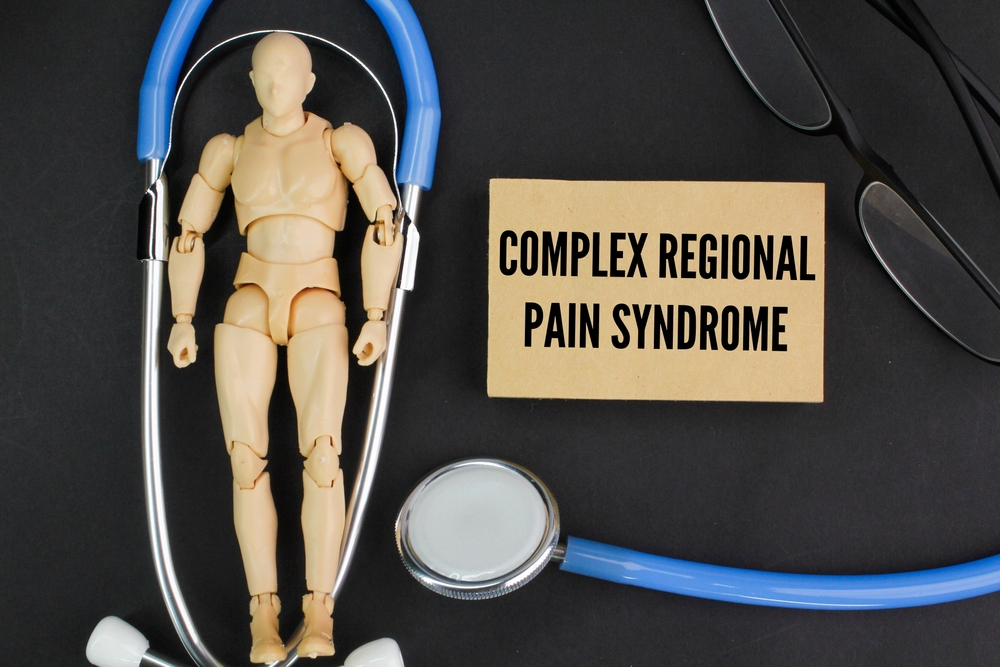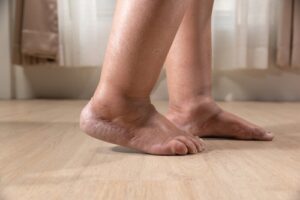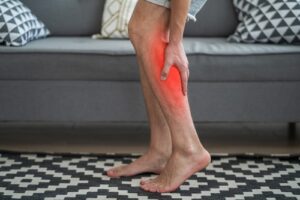Complex Regional Pain Syndrome

If you or someone you know was diagnosed with Complex Regional Pain Syndrome (CRPS) after a work-related injury or construction accident, you may feel overwhelmed and unsure of what to do next.
In this blog, we’ll explore CRPS, its symptoms, and the available treatment options. We’ll also discuss the importance of seeking legal help from a Indianapolis construction site accident lawyer if your CRPS resulted from a workplace injury or construction accident.
Schedule a Free Initial Consultation Today!
What Is Complex Regional Pain Syndrome?
Complex Regional Pain Syndrome causes chronic pain in an arm, leg, hand, or foot. It usually develops after an injury, surgery, or other traumatic event, such as a construction accident or a work-related injury. The pain associated with CRPS is often described as a burning or throbbing sensation and can hurt much more than the initial injury or trauma.
There are two types of CRPS:
- Type 1 (also known as Reflex Sympathetic Dystrophy or RSD): This type occurs after an illness or injury that did not directly damage the nerves in the affected limb.
- Type 2 (also known as Causalgia): This type occurs after a distinct nerve injury.
Symptoms of CRPS
The symptoms of CRPS can vary from person to person, but some common signs include:
Severe, Burning Pain in the Affected Limb
One of the most prominent and distressing symptoms of CRPS is severe, burning pain in the affected limb. This pain is often described as a constant, intense burning sensation that can be far more severe than the initial injury or trauma.
The pain may be localized to the affected area or can spread to nearby regions. Even the slightest touch or movement can hurt badly. This chronic pain can significantly reduce an individual’s quality of life, making it difficult to perform daily activities or even rest comfortably.
Sensitivity to Touch or Cold
Individuals with CRPS often experience heightened sensitivity to touch (allodynia) or cold (cold allodynia) in the affected limb. Even the lightest touch, such as the brush of clothing or a gentle breeze, can cause intense pain.
Similarly, exposure to cold temperatures can trigger pain or cause the existing pain to worsen. This sensitivity can make it challenging for individuals to participate in certain activities or even tolerate certain environments. This can lead to further limitations and distress.
Swelling or Stiffness in the Affected Limb
 CRPS can cause significant swelling (edema) or stiffness in the affected limb. The swelling may be localized to the affected area or can extend to nearby regions.
CRPS can cause significant swelling (edema) or stiffness in the affected limb. The swelling may be localized to the affected area or can extend to nearby regions.
This swelling can cause the limb to appear larger than the unaffected limb and can contribute to a feeling of heaviness or tightness.
Stiffness in the joints can also occur, limiting the range of motion and making it difficult to move the affected limb. These symptoms can further impair an individual’s ability to perform daily tasks and can lead to muscle weakness over time.
Changes in Skin Temperature, Color, or Texture
CRPS can cause noticeable changes in the skin of the affected limb. The skin may feel warmer or cooler to the touch compared to the unaffected limb. It may also appear red, blotchy, or shiny and can feel thin or tender. In some cases, the skin may appear pale, bluish, or mottled.
These changes in skin temperature, color, and texture are thought to be related to abnormalities in blood flow and the autonomic nervous system. These visible changes can be distressing for individuals and can serve as a constant reminder of their condition.
Changes in Hair and Nail Growth
In addition to skin changes, CRPS can also affect hair and nail growth in the affected limb. Hair growth may become excessive or may be stunted, resulting in either thick, coarse hair or sparse, thin hair. Nails may grow faster or slower than normal and may become brittle, cracked, or grooved.
These changes in hair and nail growth may relate to abnormalities in the body’s response to injury and the autonomic nervous system.
Decreased Ability to Move the Affected Limb
CRPS can significantly degrade the mobility of the affected limb. The severe pain, swelling, and stiffness can make it difficult to perform even the simplest movements.
Over time, this decreased use of the limb can lead to muscle weakness and atrophy. In severe cases, individuals may develop contractures, where the muscles and joints become fixed in a rigid, abnormal position. This decreased mobility can greatly impact an individual’s independence and ability to participate in work, hobbies, or other activities.
Muscle Spasms or Tremors
Individuals with CRPS may experience muscle spasms or tremors in the affected limb. These involuntary movements can be painful and can further contribute to the overall discomfort and disability associated with the condition.
can be painful and can further contribute to the overall discomfort and disability associated with the condition.
Muscle spasms occur when the muscles contract involuntarily, causing the limb to jerk or twitch. Tremors, on the other hand, are rhythmic, oscillating movements that can occur at rest or during movement. These distressing symptoms can make it difficult for individuals to control their movements or engage in precise tasks.
These symptoms can be debilitating and may make it difficult for individuals to perform their daily activities or return to work.
Causes of CRPS
The exact cause of CRPS is not fully understood. Doctors believe it stems from a combination of factors, including:
Injury or Trauma to the Affected Limb
One of the most common triggers for CRPS is an injury or trauma to the affected limb. This can include fractures, sprains, strains, burns, cuts, or surgical procedures. Even minor injuries that may not seem significant at the time can lead to the development of CRPS.
It is thought that the injury or trauma may cause damage to the nerves or trigger an abnormal response in the body’s pain pathways. This can lead to the onset of the severe, chronic pain and other symptoms associated with CRPS. In some cases, the injury may be work-related, such as a construction accident or a repetitive stress injury.
Because individuals who have suffered an injury may develop CRPS, they must seek prompt medical attention if they experience any unusual pain or symptoms.
Abnormal Immune System Response
Another potential contributing factor to the development of CRPS is an abnormal immune system response. The immune system is responsible for protecting the body from infection and injury, but in some cases, it may become overactive or dysregulated.
In CRPS, the immune system may mistakenly attack healthy tissues in the affected limb, leading to inflammation and damage. This abnormal immune response may be triggered by the initial injury or trauma, or it may occur independently.
Some researchers believe that certain individuals may develop CRPS due to variations in their immune system function. More research is needed to fully understand the role of the immune system in CRPS and to develop targeted therapies that can modulate this response.
Dysfunction of the Nervous System
CRPS may involve dysfunction of the nervous system, particularly the autonomic nervous system. The autonomic nervous system controls involuntary functions such as blood flow, sweating, and temperature regulation.
In CRPS, the autonomic nervous system may become dysregulated, leading to changes in skin temperature, color, and sweating in the affected limb. Additionally, the sensory nerves that transmit pain signals may become sensitized, leading to the severe, chronic pain associated with CRPS.
The exact mechanisms underlying this nervous system dysfunction are not fully understood, but it is thought to involve complex interactions between the peripheral and central nervous systems.
Researchers are working to better understand these mechanisms and to develop therapies that can target the specific neural pathways involved in CRPS.
Genetics
While the exact cause of CRPS is not fully understood, there is evidence to suggest that genetic factors may play a role in the development of the condition.
Some studies have identified specific genetic variations that may increase an individual’s risk of developing CRPS. These variations may affect the way the body responds to injury or stress or may influence the function of the immune or nervous systems.
However, it is important to note that having a genetic predisposition to CRPS does not mean that an individual will necessarily develop the condition. Other factors, such as injury or trauma, are typically necessary to trigger the onset of CRPS.
Diagnosing CRPS
Diagnosing CRPS can be challenging, as there is no single test that can confirm the condition. Instead, doctors rely on a combination of physical examinations, medical history, and diagnostic tests to make a diagnosis.
Some of the tests include:
- X-rays
- Bone scans
- MRI scans
- Nerve conduction studies
Seek medical attention if you suspect you may have CRPS. Early diagnosis and treatment can improve outcomes.
Treatment Options for CRPS
There is no cure for CRPS. However, there are several treatment options available that can help manage symptoms and improve quality of life.
Some common treatments include:
- Pain medications
- Physical therapy
- Occupational therapy
- Nerve blocks
- Spinal cord stimulation
- Psychotherapy
The specific treatment plan will depend on your symptoms, the severity of your condition, and your overall health. In some cases, a combination of treatments may be necessary to effectively manage CRPS.
Living with CRPS
Living with CRPS can be challenging, both physically and emotionally. The chronic pain and limitations caused by the condition can make it difficult to perform daily activities, work, or engage in hobbies.
Work closely with your healthcare team to develop a comprehensive treatment plan and to make any necessary lifestyle modifications.
Some tips for managing CRPS include:
- Staying active and engaged in physical therapy exercises
- Practicing stress-reduction techniques, such as meditation or deep breathing
- Maintaining a healthy diet and sleep schedule
- Seeking support from family, friends, or support groups
- Exploring alternative therapies, such as acupuncture or massage
Individuals with CRPS need a lawyer to advocate for themselves and their needs in the workplace.
CRPS and Workers’ Compensation
If your CRPS resulted from a work-related injury or construction accident, you may recover workers’ compensation benefits. These benefits can cover the cost of medical treatment, lost wages, and other related expenses.
However, the workers’ compensation system can be overwhelming, especially when dealing with a chronic condition like CRPS. That’s why it’s best to seek the help of an experienced workers’ compensation attorney who can guide you through the process and ensure that your rights are protected.
An attorney can help you:
- File a workers’ compensation claim
- Gather necessary medical evidence and documentation
- Negotiate with insurance companies
- Appeal denied claims
- Explore additional legal options, such as a personal injury lawsuit
Don’t try to navigate the workers’ compensation system alone. Seek the help of a skilled attorney who can fight for the benefits you deserve.
Contact a Workers’ Compensation Lawyer
Complex Regional Pain Syndrome is a chronic pain condition that can be devastating for those who suffer from it. If your CRPS resulted from a work-related injury or construction accident, seek an experienced workers’ compensation attorney.
An attorney can guide you through the legal process and fight for the benefits you deserve.
Don’t suffer in silence. If you or someone you know has been diagnosed with CRPS, reach out to a qualified attorney today to learn more about your rights and options. With the right legal help and medical treatment, you can manage the symptoms of CRPS and improve your quality of life.
Don’t wait any longer to get the help you deserve. The sooner you seek legal help, the better your chances of receiving the benefits and compensation you need. You face strict deadlines for filing legal claims, so speak with a Indianapolis workers’ compensation lawyer today.

